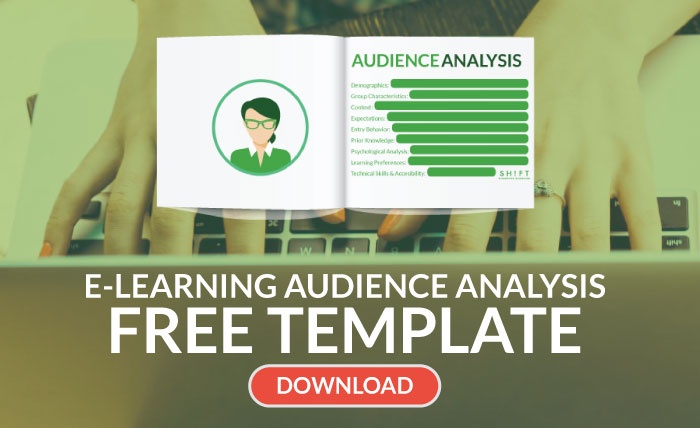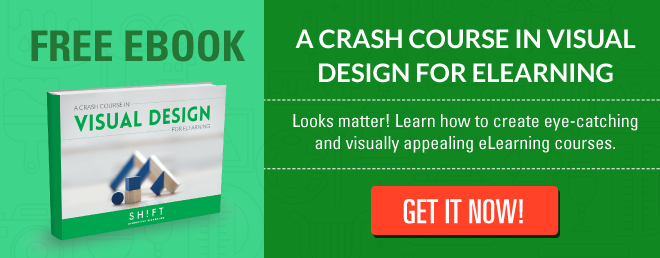With an infinite supply of content available on the Internet, how will you make your next eLearning course stand out?
Beyond merely being informative, your content must be engaging as well. Here are eight techniques you can apply today to make your learners love your eLearning courses.

1- Your eLearning Should Feel like an Experience, Rather Than Just Training
If you design it right, your learners will feel like they’ve just had a conversation with an experienced and trusted friend who shared some valuable knowledge or taught them a new skill. It takes a bit of planning, but it can be done.
A great way to do this is by using questions. Use questions to get your learners thinking about how they might approach a problem before you give them the answer. This method of asking rhetorical questions (a question asked in order to create a dramatic effect or to make a point rather than to get an answer) will engage your learners in actively thinking about the content, rather than merely being presented with information. This technique is especially useful each time you introduce a new topic, by getting your audience to think about their own experiences. It draws them in and encourages them to continue.
What are some other ways to make your eLearning content engaging? Glad you asked. Let’s look at some more tips. (See what just happened?)
Read more: Learner Experience Mapping: Building Personalized “Learner-centric” Experiences
2) Know Your Audience
Before ever deciding on how are you going to design the course, take the time to know your audience. It’s extremely difficult to engage someone who you don’t know. It would be like trying to get someone’s attention in a crowded store but calling out someone else’s name, it simply isn’t going to work
Pick a style and tone that will resonate with your learners. This may mean that you will need several different levels of training for a specific topic. For example, you may need to offer a beginning, intermediate, and advanced course on something like presentation skills, depending on the knowledge, skills, and characteristics of your target audience.
Select your vocabulary and examples that reflect the proper fit for your audience. For example, if you are addressing seasoned professionals with extensive experience in the area of presentation skills, you will only briefly cover the basics (e.g., voice projection), and concentrate on more advanced topics (e.g., handling disruptive participants).
3) Keep eLearning Focused On The Topic At Hand, and Relevant to Your Learners
Again, the Internet is swimming with content, so your eLearning course needs to keep its focus, and provide information that is focused on your stated training objectives. While it is important to provide useful examples, make certain that they are on-topic. Don’t go off on tangents! Make sure that you emphasize only what your audience needs to know. If you have additional content that might be “nice to know,” you can always provide a link to it for those you might be interested in knowing more about.
Remember, your learners are like your customers, and if you don’t show them something they want, then they aren’t going to feel engaged to continue taking your course. Like developing any product, great eLearning courses need to use tools to get to know their "customers" so they can better "sell" to them.
Read more: The #1 Way to Engage Adult Learners? Be Relevant
4) Actionable and Inspiring Writing Style
Great eLearning courses don’t stop at being interesting, they take that engagement and use it to push audiences, customers, and company leaders into ACTION. Your words need to connect with the audience on an intellectual level and work in conjunction with other design elements to be inspiring, persuasive, and actionable. You want learners to be able to DO something not only during the course but also after they've completed it.
Nothing is worse than reading content that is monotonous and boring. This happens when you use the same adjectives over and over and never vary your sentence structure. Make your content engaging by varying your sentence structure and vocabulary, as well as adding elements to keep the learner interested. One technique is to vary the length of your sentences and change up your rhythm. Wake up your audience. Throw in a short sentence. Then go back to longer sentences with more information when the content supports it.
Another great way to keep your content inspiring is by using stories, analogies, quotes, and examples to illustrate the critical points of your material. Make sure, however, that they are appropriate for your intended audience. And don’t get carried away with stories that drift away from the topic. This brings us to our next point.
Check out this guide: The Do’s and Don’ts of Writing for eLearning
5) Write with Short Attention Spans in Mind
With so many other activities competing for your learners’ attention, you will need to keep your course short and sweet. People hate wasting time on anything that isn’t relevant and valuable, so make sure your course doesn’t include anything that makes be called “fluff,” such as unnecessary activities or complexity.
That’s not to say that you can’t inject some humor. Your learners will respond to the occasional (relevant and tasteful) joke, which will also help maintain their interest. Remember that you are competing with YouTube videos and other interactive content for their time and attention.
Read more: Create Your eLearning Course to Grab Your Learner's Attention Faster
6) Use Catchy Titles and Sub-titles
If you don’t catch the attention of potential learners with your title, they aren’t likely to click on your course (unless it’s mandatory). You need to entice them with a title that will draw them in with the key benefits of your course, while still delivering on your promise. You do this by appealing to what your audience wants to have, who they want to be, and what they want to accomplish. State how your course will help them get those things.
For example, you might write a course on the ten steps to writing a successful business plan. One title might be, “Ten Steps to a Successful Business Plan.” But that doesn’t tell your audience how they will benefit. A better title might be, “How to Write a Business Plan That Has Investors Excited to Give You Money.” It’s the same content, but the second one sells the benefits of your course in an emotional appeal.
7) Use visuals
Look at yourself. Would you like to watch a demo video and learn how to fix a broken washer or read through the pages of the instruction manual?
As an eLearning developer whose goal is to create engaging learning, you MUST NOT pass up this medium when you design your eLearning courses.
Include photos, videos, infographics, and charts to enhance your content and help you connect with your learners. These visual elements will help you make your course more engaging and memorable, as well as easier to absorb. Remember the old saying, “A picture is worth a thousand words?”
Here're some other helpful tips:
- Use visuals that support goals: When you’re not sure if some graphic helps, or hinders your goal, it’s usually best to leave it out. Ask yourself if what you’re trying to add will help your learners’ retention or meeting of their goals. If the answer is no, let it go.
- Embrace different formats. For instance, insert visuals to break the monotony of a seemingly endless series of text. You can also create infographics to liven up content, say, for example, a list of statistics. Use animated visuals to explain complex procedures. For instance, an animated GIF that demonstrates the steps of a procedure is more effective as a learning tool than a chunk of text. It is the next best thing to attend a workshop and see a demonstrator perform the steps right in front of you.
- Take your time to choose images: Choosing images should not be an after-thought. It is not a chore that you approach without a thought and then do a slapdash job of it. A relevant, memorable image is a powerful instructional tool that drives learner engagement, reduces cognitive load, and fulfills the learning objectives most efficiently. The images you use in a course are as important as the text you write, the interactions you design, and the assessments you include.
Learn about the ten most useful tools that you can incorporate into your eLearning courses to get your content to stick and resonate with your audience here.
Making the Most of Visuals in eLearning: 9 Tips and 5 Examples
8) Be Conversational, Friendly, and Energetic
If your eLearning course starts to sound like a scholarly journal, you will lose your audience. Learners don’t respond well to online instruction that does not take into account their level of understanding. Learners should be able to understand your meaning easily. Using conversational vocabulary will help you achieve this. Say things like “let’s try this,” rather than “you should do this.”
Using a compassionate tone will help you connect with your audience, and engage them with your content.
Write your content as if you were talking to a friend. Talking “down” to your audience or using complex language will make your audience feel subordinate to you and alienate them. They don’t want to be impressed with your extensive vocabulary. They want you to teach them something and help them solve their problems.
Hopefully, you’ve found one or more tips that you can begin using right away to create more engaging content. And when your content is more engaging, your learners will get more out of your eLearning course. It’s a win-win!



